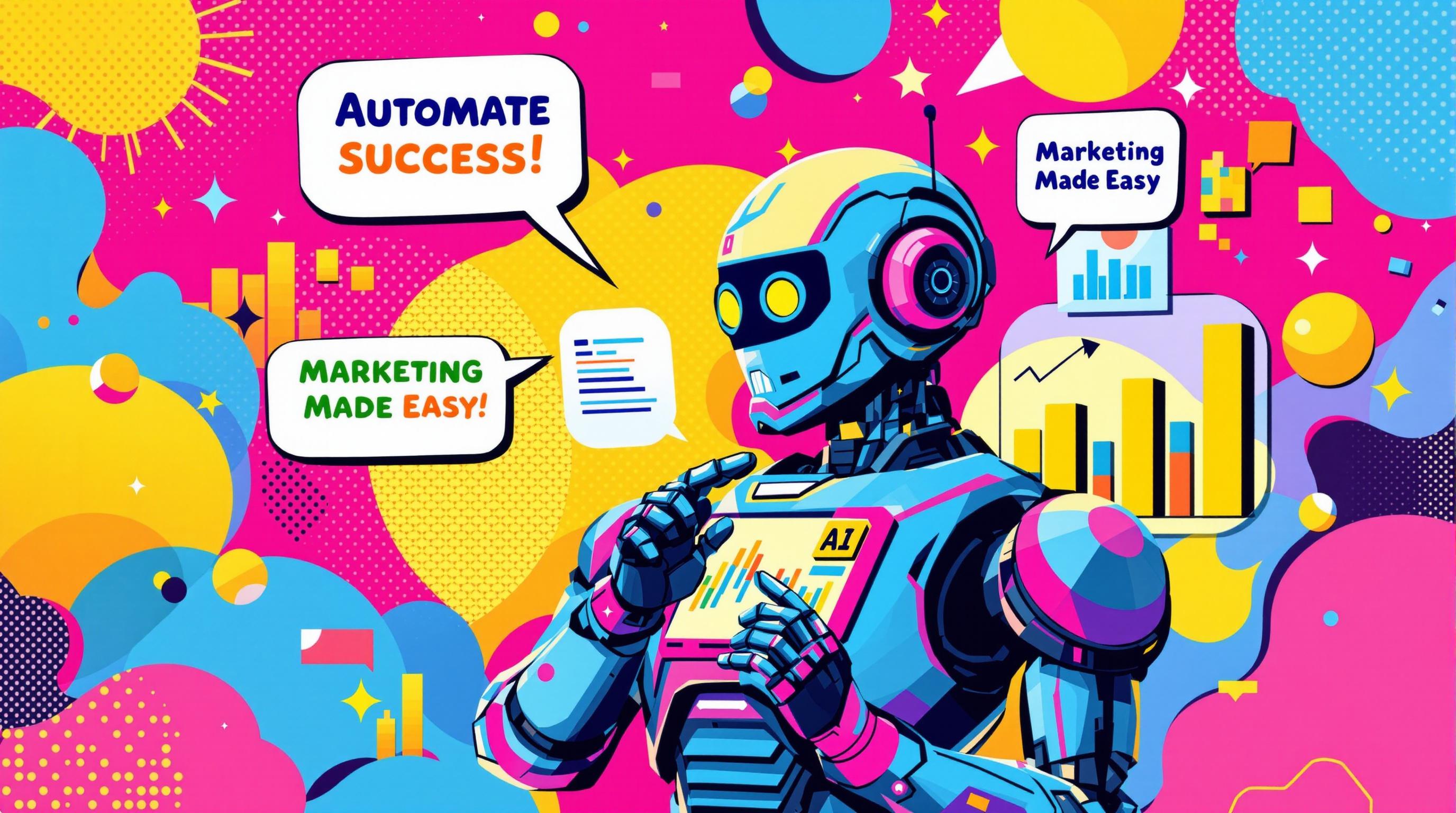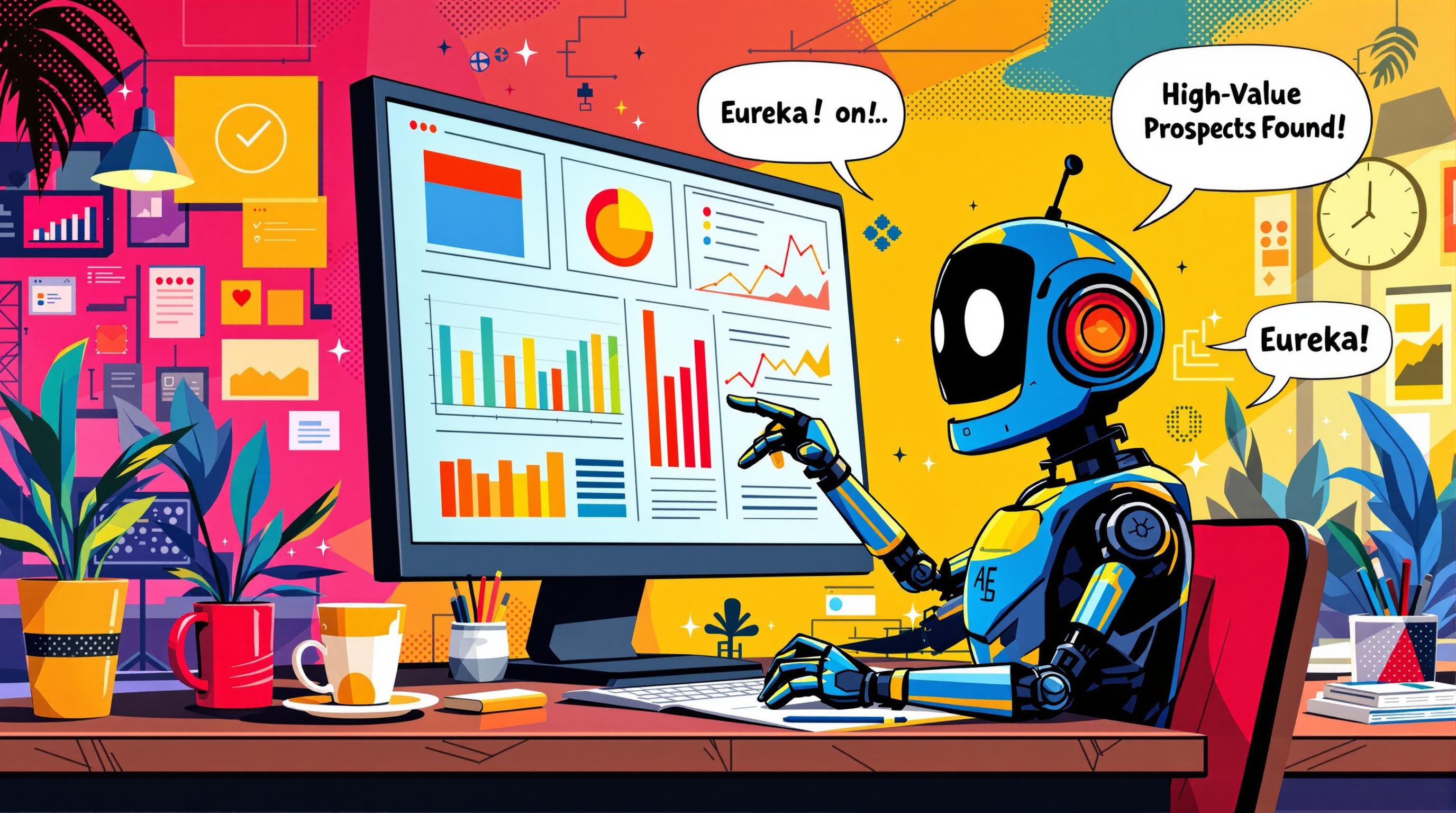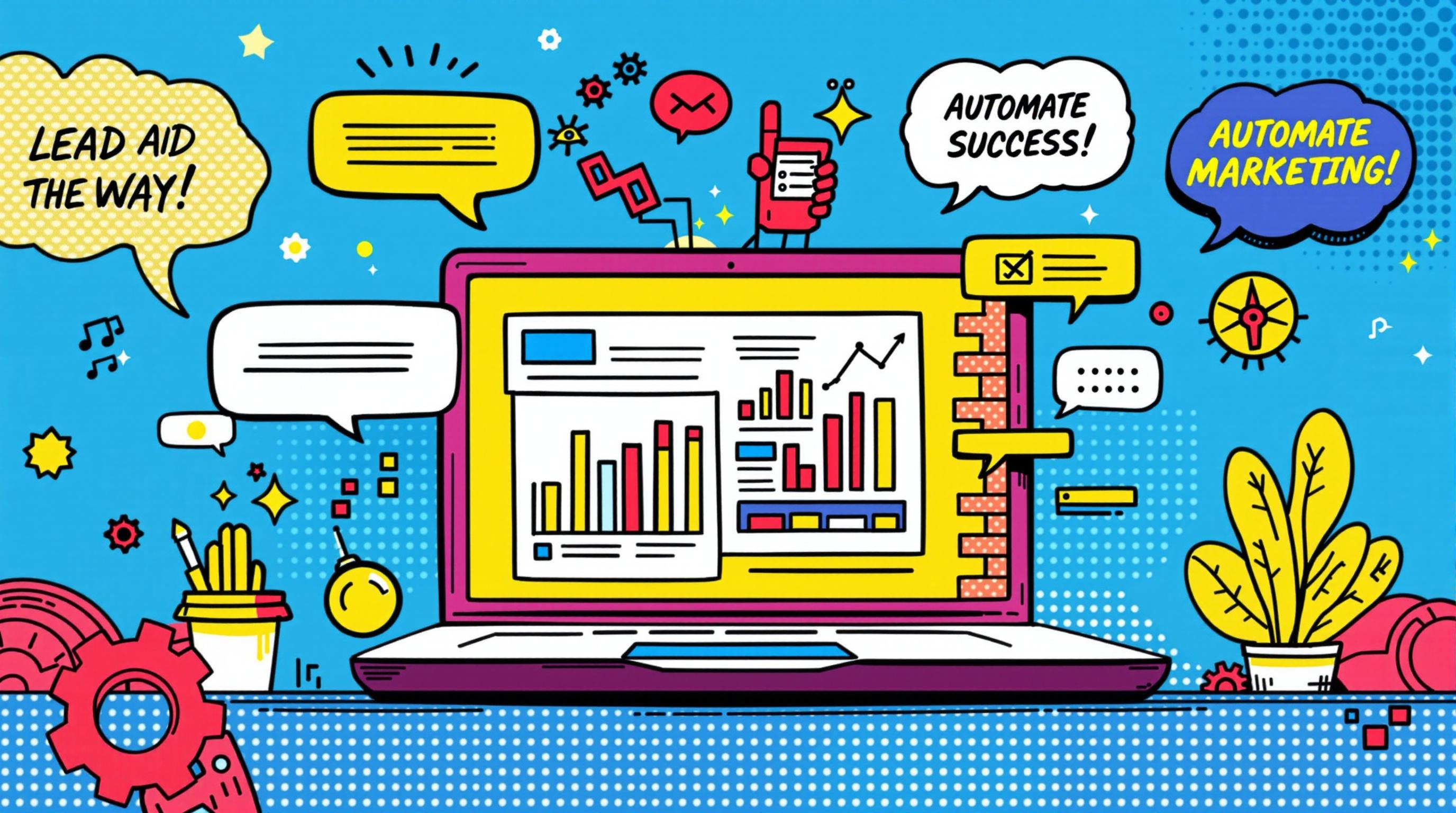AI Marketing Agents and basic automation both help businesses save time, but they work very differently. Here’s a quick breakdown:
- Basic Automation: Handles simple, repetitive tasks using fixed rules (e.g., sending scheduled emails or posting on social media). It’s static and doesn’t adapt to new data.
- AI Marketing Agents: Go beyond automation by learning and improving over time. They analyze data, make real-time decisions, and personalize customer experiences (e.g., dynamic ad targeting or behavior-based campaigns).
Key Takeaways:
- AI tools adapt and improve, while basic automation follows pre-set rules.
- AI is better for complex tasks like predictive analytics and personalized marketing.
- Basic automation is ideal for routine, rule-driven tasks.
Quick Comparison
| Feature | Basic Automation | AI Marketing Agents |
|---|---|---|
| Decision Making | Fixed rules | Data-driven, adaptive decisions |
| Learning | None | Learns and improves over time |
| Task Complexity | Simple, repetitive tasks | Complex, multi-step processes |
| Personalization | Limited | Highly personalized |
| Updates | Manual | Real-time adjustments |
Choose basic automation for straightforward tasks. Use AI agents for smarter, faster, and more personalized marketing strategies.
Basic Automation vs. AI Marketing Agents: Core Differences
Basic Automation Explained
First-generation automation tools marked the early days of marketing technology. These systems follow strict, pre-programmed rules to manage repetitive tasks. For instance, they can send out emails on a schedule, post social media updates at set times, or trigger actions based on simple "if-then" logic. While they are great for handling routine work, they lack the ability to make decisions outside their programmed scope. For example, an email automation tool might send a follow-up email three days after a customer's initial contact, regardless of whether that timing aligns with the customer's specific needs.
AI Marketing Agents Explained
AI marketing agents are more advanced tools that can analyze data, learn from it, and make decisions independently. Powered by machine learning, these systems process vast amounts of information and improve their performance over time. Claire Johnson, a digital marketing strategist at a leading advertising firm, highlights their impact:
"As a digital marketing strategist, I've witnessed firsthand the transformative power of AI agents in our operations. These intelligent tools can analyze consumer behavior with such depth and precision that creating highly targeted campaigns has become our new norm."
These tools don't just execute tasks - they adapt and evolve, making them invaluable for modern marketing strategies.
Main Differences
| Feature | Basic Automation | AI Marketing Agents |
|---|---|---|
| Decision Making | Operates on fixed rules | Makes adaptive, data-informed decisions |
| Learning Capability | No learning ability | Continuously improves using machine learning |
| Task Complexity | Handles simple, repetitive tasks | Manages complex, multi-step processes |
| Adaptability | Static, unchanging responses | Adjusts dynamically using real-time data |
| Integration | Limited to specific functions | Connects seamlessly across various systems |
These differences translate into measurable results. Companies using AI marketing agents often experience a 10–20% boost in efficiency and productivity. Dr. Michael Chen, a Professor of Marketing and Technology, explains:
"The process automation AI agents offer is unprecedented, seamlessly integrating tasks that used to take teams of analysts weeks to complete. Their real-time analysis and rapid A/B testing allow swift strategy pivots."
While basic automation can increase revenue through segmentation (up to 760%), AI marketing agents take this further by leveraging real-time insights and personalized strategies. It's no surprise that experts predict 45% of the marketing workforce will rely on AI tools by 2030.
How Each System Makes Decisions
AI Learning Process
AI marketing agents rely on a machine-learning decision engine that uses reasoning, memory, and dynamic execution to process both structured and unstructured data. This enables them to make complex decisions by analyzing multiple factors simultaneously.
Murali Swaminathan, chief technology officer at Freshworks, describes this shift:
"Dynamic workflows powered by agentic AI are shifting the paradigm from process automation to process intelligence. They will enable businesses to automate not only routine tasks but also decision-making - making workflows smarter, more efficient, and capable of delivering higher value."
A great example of this is Advolve's AI platform, which manages digital marketing campaigns with impressive accuracy. The system cut operational work time by 90% while boosting customer return on ad spend (ROAS) by 15%. This advanced decision-making has drawn enterprise clients like iFood and Cogna in Brazil.
Basic Automation Boundaries
Basic automation operates within rigid "if-then" decision trees, making it effective for routine tasks but limited in handling complex scenarios. These systems are best suited for processing structured data but lack flexibility and contextual understanding.
Here are some common limitations of basic automation:
| Limitation | Impact |
|---|---|
| Fixed Rules | Requires manual updates for any adjustments |
| Data Processing | Only works with structured data formats |
| Error Handling | Stops at exceptions, needs human input |
| Personalization | Limited ability to customize contextually |
| Integration | Can create data silos across systems |
Live Updates vs. Fixed Rules
The way each system handles updates is a key difference. Basic automation sticks to pre-set rules, regardless of the outcomes. In contrast, AI agents analyze live data and adjust their decisions in real-time. This dynamic approach allows for ongoing optimization, delivering much better results.
João Sobreira, co-founder of Advolve, explains the importance of this capability:
"Our main challenge was to create a complex system connecting multiple software, platforms, and data inputs - way beyond human capabilities."
The benefits of real-time decision-making are clear. Businesses using AI-driven attribution modeling can boost their marketing ROI by up to 30%. AI agents use real-time insights to activate multi-channel triggers, keeping campaigns relevant.
Unlike basic automation, AI agents improve over time through continuous learning. This makes them especially valuable in fast-changing marketing scenarios where quick adjustments are essential for success.
Where to Use Each System
Best Uses for Basic Automation
Basic automation shines in handling simple, rule-based tasks. For example, automated welcome emails can deliver an impressive ROI of $42 for every dollar spent. These systems are most effective when tasks have clear, predefined rules and don't require complex decision-making.
Here are some common applications for basic automation:
- Scheduling social media posts at specific times
- Sending triggered emails like welcome messages or order confirmations
- Routing customer support tickets based on simple criteria
- Running pre-set email drip campaigns
- Generating reports on a regular schedule
While basic automation is great for repetitive tasks, it can't handle situations that require deeper analysis or real-time adjustments. That's where AI agents come in.
Best Uses for AI Agents
AI marketing agents excel in tasks that involve analyzing large amounts of data and making real-time decisions. For instance, a D2C fashion brand used AI to analyze data like purchase history and weather patterns to refine its marketing strategy. The system found that customers engaging with sustainability-related content were 30% more likely to buy eco-friendly products.
AI agents are especially effective for:
- Managing dynamic ad targeting and bidding strategies
- Creating and delivering personalized content
- Performing complex customer segmentation
- Optimizing campaigns across multiple channels
- Using predictive analytics to forecast trends
For example, a real estate firm used AI to study market trends, seasonal shifts, and user behavior. This approach tripled their conversions and cut cost-per-lead by 60%. Similarly, an e-commerce platform that implemented AI-driven personalization saw a 40% drop in bounce rates and a 25% increase in customer retention within six months.
Task Comparison Chart
The chart below highlights how basic automation and AI marketing agents differ in handling key marketing tasks:
| Marketing Task | Basic Automation | AI Marketing Agent |
|---|---|---|
| Email Marketing | Fixed schedules, welcome sequences | Personalized messaging, dynamic send times, behavior-based campaigns |
| Ad Management | Basic retargeting, scheduled posts | Real-time bid adjustments, creative optimization, audience discovery |
| Content Creation | Template-based responses | Context-aware content generation, adaptive messaging |
| Customer Segmentation | Static, rule-based groups | Dynamic micro-segments, behavioral clustering |
| Performance Tracking | Standard metric reporting | Predictive insights, pattern recognition, automated strategy adjustments |
Combining basic automation for routine tasks with AI agents for complex decision-making creates a well-rounded marketing system that boosts efficiency and delivers better outcomes.
sbb-itb-3fa07bc
Working with Human Marketers
AI as Marketing Support
AI marketing tools act as analytical partners, helping teams extract actionable insights from vast amounts of data. Companies using AI report productivity boosts of up to 40%. By automating time-consuming tasks, AI allows marketers to focus on strategy and creativity.
Virgin Holidays used AI to enhance their email marketing, specifically for crafting subject lines. Saul Lopes, their CRM, CX, and Loyalty Lead, shared:
"In the first two minutes I wanted it. I saw the ability to save time and test a lot more, rather than a human giving me two or three variations that are pretty similar."
The payoff? A 2% increase in open rates, which translated to millions in additional revenue. Plus, the time required to create subject lines dropped from weeks to just minutes.
AI supports marketing teams by:
- Analyzing customer data to identify trends
- Delivering real-time performance insights
- Testing multiple content variations at once
- Ensuring brand compliance in generated content
This level of analytical support creates a strong foundation for collaboration with human creativity.
Combining AI and Human Skills
While AI is great at crunching numbers and analyzing data, human marketers bring creativity, emotional intelligence, and strategic thinking to the table. Together, they form a powerful duo.
Eva Miller, VP of Marketing at Digital Silk, highlights this balance:
"The magic of AI lies in its ability to turn mountains of data into meaningful, personalized experiences that make customers feel truly understood and valued."
To make this partnership work, organizations should:
- Clearly define team roles and establish feedback loops to refine AI outputs.
- Train teams to effectively manage and interpret AI-generated insights.
The results of combining human and AI efforts are hard to ignore. Companies leveraging this collaboration have reported:
- 10-20% improvements in cost efficiency
- Up to 760% revenue growth from segmented campaigns
- 71% of consumers now expect personalized experiences
Abhishek Gandotra, a Strategic Decision-Making Expert, sums it up well:
"The future of marketing lies not in choosing between human creativity and AI analytical power, but in learning how to combine them effectively for maximum impact."
A.I. Agents For Digital Marketing: The Ultimate Guide
Conclusion: Making the Right Choice
When deciding between AI-driven tools and rule-based automation, your marketing goals should take the lead. For example, 48% of marketers focus on brand awareness, while 43% aim for revenue growth.
If your tasks are repetitive and follow clear rules, basic automation might be enough. But for goals like personalized customer experiences or dynamic campaign adjustments, AI marketing agents are the better fit. Here's a simple breakdown:
| Aspect | Basic Automation | AI Marketing Agents |
|---|---|---|
| Scalability | Needs more resources to expand | Expands without added proportional costs |
| Flexibility | Fixed workflows | Adjusts in real time |
| Decision Making | Rule-based | Uses data and predictive analytics |
AI marketing agents go beyond automating - they refine campaigns in real time. Take Starbucks, for instance. Their rewards program uses AI to deliver personalized promotions, which now account for 39% of their total sales.
To get the most out of your marketing strategy:
- Set SMART goals that align with your business objectives.
- Review your current processes to spot areas for automation.
- Track ROI using clear metrics - 54% of marketers prioritize web traffic as a key success measure.
Abhishek Gandotra, a Strategic Decision-Making Expert, sums it up perfectly:
"The future of marketing lies not in choosing between human creativity and AI analytical power, but in learning how to combine them effectively for maximum impact."



